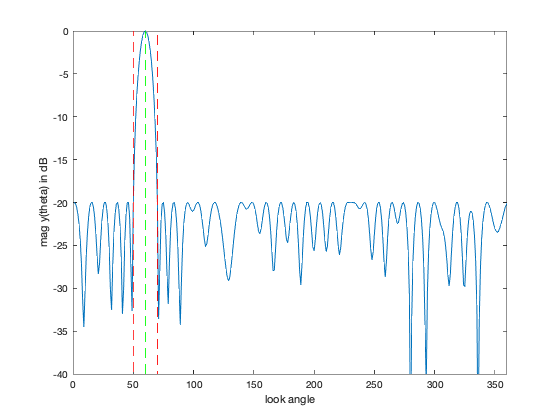ARRAY_GEOMETRY = '2D_RANDOM';
lambda = 1;
theta_tar = 60;
min_sidelobe = -20;
max_half_beam = 50;
if strcmp( ARRAY_GEOMETRY, '2D_RANDOM' )
rand('state',0);
n = 36;
L = 5;
loc = L*rand(n,2);
elseif strcmp( ARRAY_GEOMETRY, '1D_UNIFORM_LINE' )
n = 30;
d = 0.45*lambda;
loc = [d*[0:n-1]' zeros(n,1)];
elseif strcmp( ARRAY_GEOMETRY, '2D_UNIFORM_LATTICE' )
m = 6; n = m^2;
d = 0.45*lambda;
loc = zeros(n,2);
for x = 0:m-1
for y = 0:m-1
loc(m*y+x+1,:) = [x y];
end
end
loc = loc*d;
else
error('Undefined array geometry')
end
theta = [1:360]';
A = kron(cos(pi*theta/180), loc(:,1)') + kron(sin(pi*theta/180), loc(:,2)');
A = exp(2*pi*i/lambda*A);
[diff_closest, ind_closest] = min( abs(theta - theta_tar) );
Atar = A(ind_closest,:);
halfbeam_bot = 1;
halfbeam_top = max_half_beam;
disp('We are only considering integer values of the half beam-width')
disp('(since we are sampling the angle with 1 degree resolution).')
disp(' ')
while( halfbeam_top - halfbeam_bot > 1)
halfbeam_cur = ceil( (halfbeam_top + halfbeam_bot)/2 );
ind = find(theta <= (theta_tar-halfbeam_cur) | ...
theta >= (theta_tar+halfbeam_cur) );
As = A(ind,:);
cvx_begin quiet
variable w(n) complex
Atar*w == 1;
abs(As*w) <= 10^(min_sidelobe/20);
cvx_end
if strfind(cvx_status,'Solved')
fprintf(1,'Problem is feasible for half beam-width = %d degress\n',...
halfbeam_cur);
halfbeam_top = halfbeam_cur;
else
fprintf(1,'Problem is not feasible for half beam-width = %d degress\n',...
halfbeam_cur);
halfbeam_bot = halfbeam_cur;
end
end
halfbeam = halfbeam_top;
fprintf(1,'\nOptimum half beam-width for given specs is %d.\n',halfbeam);
ind = find(theta <= (theta_tar-halfbeam) | ...
theta >= (theta_tar+halfbeam) );
As = A(ind,:);
cvx_begin quiet
variable w(n) complex
minimize( norm( w ) )
subject to
Atar*w == 1;
abs(As*w) <= 10^(min_sidelobe/20);
cvx_end
figure(1), clf
plot(loc(:,1),loc(:,2),'o')
title('Antenna locations')
y = A*w;
figure(2), clf
ymin = -40; ymax = 0;
plot([1:360], 20*log10(abs(y)), ...
[theta_tar theta_tar],[ymin ymax],'g--',...
[theta_tar+halfbeam theta_tar+halfbeam],[ymin ymax],'r--',...
[theta_tar-halfbeam theta_tar-halfbeam],[ymin ymax],'r--');
xlabel('look angle'), ylabel('mag y(theta) in dB');
axis([0 360 ymin ymax]);
figure(3), clf
zerodB = 50;
dBY = 20*log10(abs(y)) + zerodB;
plot(dBY.*cos(pi*theta/180), dBY.*sin(pi*theta/180), '-');
axis([-zerodB zerodB -zerodB zerodB]), axis('off'), axis('square')
hold on
plot(zerodB*cos(pi*theta/180),zerodB*sin(pi*theta/180),'k:')
plot( (min_sidelobe + zerodB)*cos(pi*theta/180), ...
(min_sidelobe + zerodB)*sin(pi*theta/180),'k:')
text(-zerodB,0,'0 dB')
text(-(min_sidelobe + zerodB),0,sprintf('%0.1f dB',min_sidelobe));
theta_1 = theta_tar+halfbeam;
theta_2 = theta_tar-halfbeam;
plot([0 55*cos(theta_tar*pi/180)], [0 55*sin(theta_tar*pi/180)], 'k:')
plot([0 55*cos(theta_1*pi/180)], [0 55*sin(theta_1*pi/180)], 'k:')
plot([0 55*cos(theta_2*pi/180)], [0 55*sin(theta_2*pi/180)], 'k:')
hold off
We are only considering integer values of the half beam-width
(since we are sampling the angle with 1 degree resolution).
Problem is feasible for half beam-width = 26 degress
Problem is feasible for half beam-width = 14 degress
Problem is not feasible for half beam-width = 8 degress
Problem is feasible for half beam-width = 11 degress
Problem is feasible for half beam-width = 10 degress
Problem is not feasible for half beam-width = 9 degress
Optimum half beam-width for given specs is 10.


